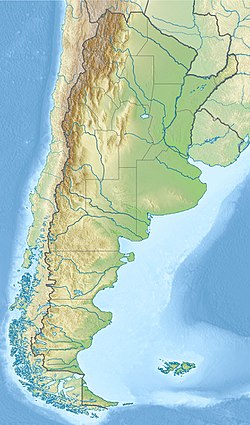| Los Llanos Formation | |
|---|---|
| Stratigraphic range: Campanian ~ | |
| Type | Geological formation |
| Underlies | exposed to surface |
| Overlies | Unconformity with Early Permian Los Sauces & Patquía Formations or Ordovician granitic basement |
| Thickness | Up to ~150 m (490 ft) |
| Lithology | |
| Primary | Sandstone, conglomerate |
| Other | Paleosols |
| Location | |
| Coordinates | 30°36′S66°36′W / 30.6°S 66.6°W |
| Approximate paleocoordinates | 33°48′S39°30′W / 33.8°S 39.5°W |
| Region | La Rioja Province |
| Country | Argentina |
| Extent | Sanagasta geological park , Sierra de Los Llanos, Sierra de Chepes, Sierra Ulapes, Sierra de Velasco & Sierra Brava |
| Type section | |
| Named for | Sierra de Los Llanos |
| Named by | Bodenbender |
| Year defined | 1911 |
Los Llanos Formation is a geological formation in the La Rioja Province, northwestern Argentina whose strata date back to the Campanian stage of the Late Cretaceous.
Contents
Los Llanos Formation over the years has been controversially described as ranging from Late Cretaceous to Miocene, but the Miocene succession was assigned to Las Mulitas Formation in 2019. The formation rests on top of the Early Permian Los Sauces and Patquía Formations and in parts on Ordovician crystalline basement. The maximum thickness is estimated at 150 metres (490 ft).
The sandstones and conglomerates of the formation were deposited ij a fluvial environment. The formation crops out in the Sanagasta geological park , where more than 90 titanosaurid nesting sites were discovered in Los Llanos Formation. The sites were encountered on top of areas characterized by hydrothermal activity as geysers and other vents, suggesting a preferred location for the incubation of the dinosaur eggs. Apart from fossil eggs, the formation has provided fossil flora and ostracods. The crocodyliform Llanosuchus , described in 2016 from the formation, was named after Los Llanos Formation.



